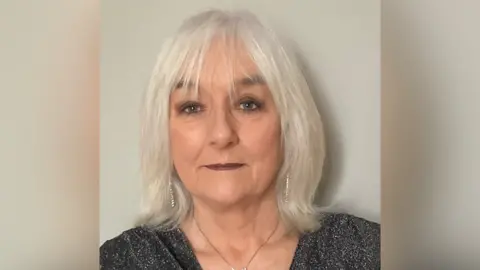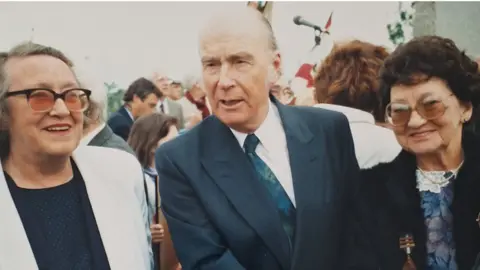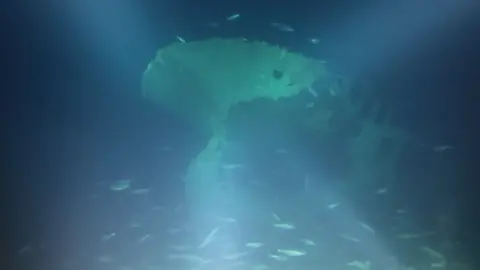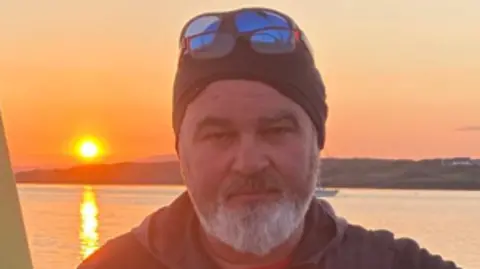'Wreckage could allow me to bury uncle killed by Hitler's navy'
 Handout
HandoutThe family of a young Irish seaman killed when his trawler was sunk by a German U-boat in 1940 say they hope the discovery of the wreckage will finally allow them to give him a Christian burial.
Mary Duggan's uncle, Michael Cullen was one of a crew of 11 who died when the Leukos, an unarmed neutral Irish vessel, was attacked without warning by submarine U-38.
The wreckage was found in the Atlantic Ocean about 30 miles (48km) off the coast of County Donegal in the Republic of Ireland.
Ms Duggan said they always knew Michael, who was 17, had been "lost at sea" but never that he had been a victim of Nazi Germany.
For her, it was "very sad" that Michael's body had never been recovered after 85 years and may be lying at the bottom of the ocean.
 Liam Duggan
Liam DugganShe said she was amazed the wreckage had now been found.
"Foremost in my mind is just, maybe, getting the remains of my uncle," Ms Duggan said.
"My [late] father, my [late] grandparents would, I'm sure, be delighted to know that a shipwreck has been found and maybe there's a possibility of having a burial for Michael.
"It might be just something I could do for my dad; he was his brother."
Why did the U-boat attack the Leukos?
The Leukos had been fishing alongside five British trawlers off Tory Island on 9 March 1940 when the submarine surfaced and opened fire with its deck gun.
As a neutral country, all Irish ships, including the Leukos, were unarmed and clearly marked.
It has never been proven why U-38 fired at the unarmed neutral Irish trawler, and left five British vessels untouched.
In his log, the U-boat captain Heinrich Liebe wrote: "I decided to administer a warning to one of them with the (deck) gun."
At 21:13, and within about 200m of the target, the U-boat fired a single round at the ship, hitting her in the engine room.
The U-boat withdrew, staying on the surface for about one hour, until the ship foundered.
There are several theories about why it was singled out by the German navy.
One is that the Leukos had positioned herself between the fleeing British trawlers in the hope that the U-boat would respect Irish neutrality.
Another that she tried to ram the U-boat.
This is the view taken by the Irish Seamen's Relatives Association which holds that the Leukos attempted to ram the U-38 as it threatened the British fishing fleet.
They maintain that this "selfless bravery" should be acknowledged by the British government. Downing Street has been asked for comment.
Death certificates for the lost crew were not issued until 1986.
The Leukos was only reported missing three days after the attack, when it failed to return to Dublin.
The crew included skipper James Potter Thomasson, William Donnelly, Patricio McCarthy, Alexander McLeod, Thomas Mulligan, Andrew Pill, PJ Scanlon and Bernard Smith.
Several teenagers were also on board, including James Hawkins, Michael Cullen, and Robert Sumler.
They were from the Irish Free State (now the Republic of Ireland), England and Scotland.
Michael's name and those of his fellow shipmates are included on a monument unveiled by President of Ireland Patrick Hillery at City Quay in Dublin in 1990 to commemorate all Irish seafarers killed during World War Two.
It was attended by the teenager's sisters, Dora Dobbyns and Winnie Sheehy, and Mary Duggan's mother, May Tierney.
A painting of the Leukos is kept at the National Maritime Museum in Dún Laoghaire, County Dublin.
 John Kearney
John KearneyFormer Irish Naval Service diver John Kearney, who found the shipwreck, believes the crew "died trying to save the lives of seamen in nearby British vessels".
He found the wreckage about 12 nautical miles off Tory Island at the end of May and said a team of international forensics experts had authenticated the discovery.
He used an Atlantic Submersible 2, which took him and a diving buddy to the seabed.
"I could see the rudder, the propeller, the engine space but the wheelhouse had gone," he said.
 Handout
HandoutMr Kearney described the crew of the Leukos as an "easy target" for the German navy because they were unarmed.
"They were the same age as my own children, they were young kids going to sea for the first time," he said.
"What they did was they saved a lot of lives on the other (British) boats that were there.
"They left Dublin looking to go fishing off the north west coast with an Irish-registered vessel and they paid for it with their lives."
 National Maritime Museum of Ireland
National Maritime Museum of Ireland